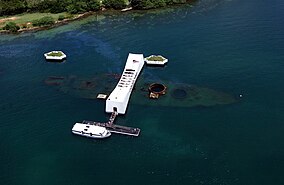USS Arizona Memorial
| USS Arizona Memorial | |
|---|---|
|
IUCN category V (protected landscape/seascape)
|
|

USS Arizona Memorial
|
|
| Location | Pearl Harbor |
| Nearest city | Honolulu, Hawaii |
| Coordinates | 21°21′54″N 157°57′0″W / 21.36500°N 157.95000°WCoordinates: 21°21′54″N 157°57′0″W / 21.36500°N 157.95000°W |
| Area | 10.50 acres (4.25 ha) |
| Established | May 30, 1962 |
| Visitors | 1,556,808 (in 2005) |
| Governing body |
U.S. Navy National Park Service |
| Website | World War II Valor in the Pacific National Monument |
The USS Arizona Memorial, at Pearl Harbor in Honolulu, Hawaii, marks the resting place of 1,102 of the 1,177 sailors and Marines killed on USS Arizona (BB-39) during the Japanese surprise attack on Pearl Harbor on December 7, 1941 and commemorates the events of that day. The attack on Pearl Harbor and the island of Oʻahu led to the United States' direct involvement in World War II.
The memorial, built in 1962, is visited by more than two million people annually. Accessible only by boat, it straddles the sunken hull of the battleship without touching it. Historical information about the attack, shuttle boats to and from the memorial, and general visitor services are available at the associated USS Arizona Memorial Visitor Center, which opened in 1980 and is operated by the National Park Service. The battleship's sunken remains were declared a National Historic Landmark on May 5, 1989.
The USS Arizona Memorial is one of several sites in Hawaii and elsewhere that are part of the World War II Valor in the Pacific National Monument.
During and following the end of World War II, the Arizona's wrecked superstructure was removed and efforts began to erect a memorial at the remaining submerged hull. The Pacific War Memorial Commission was created in 1949 to build a permanent memorial in Hawaii. Admiral Arthur W. Radford, commander of the Pacific Fleet attached a flag pole to the main mast of the Arizona in 1950 and began a tradition of hoisting and lowering the flag. In that same year a temporary memorial was built above the remaining portion of the deckhouse. Radford requested funds for a national memorial in 1951 and 1952 but was denied because of budget constraints during the Korean War.
...
Wikipedia
